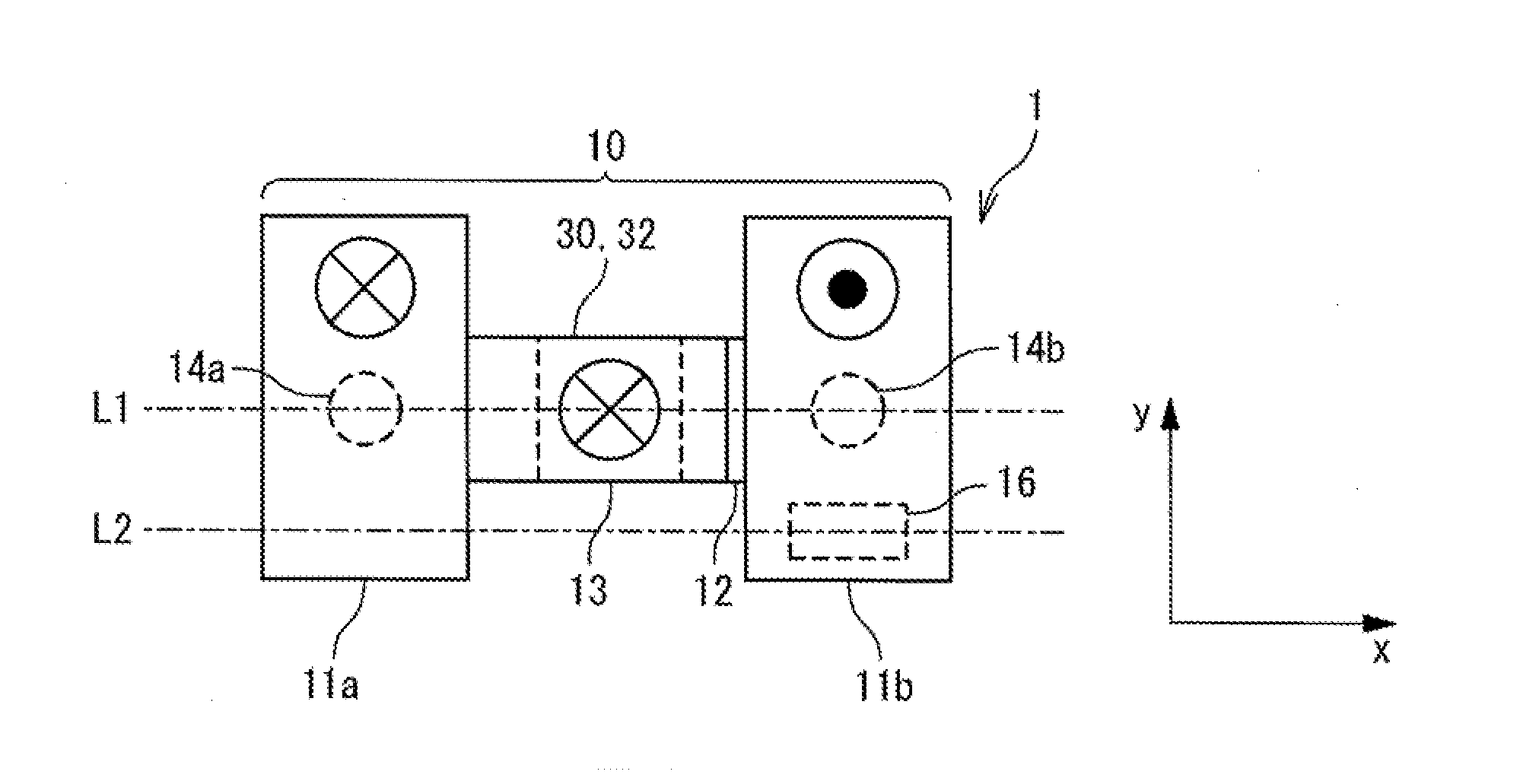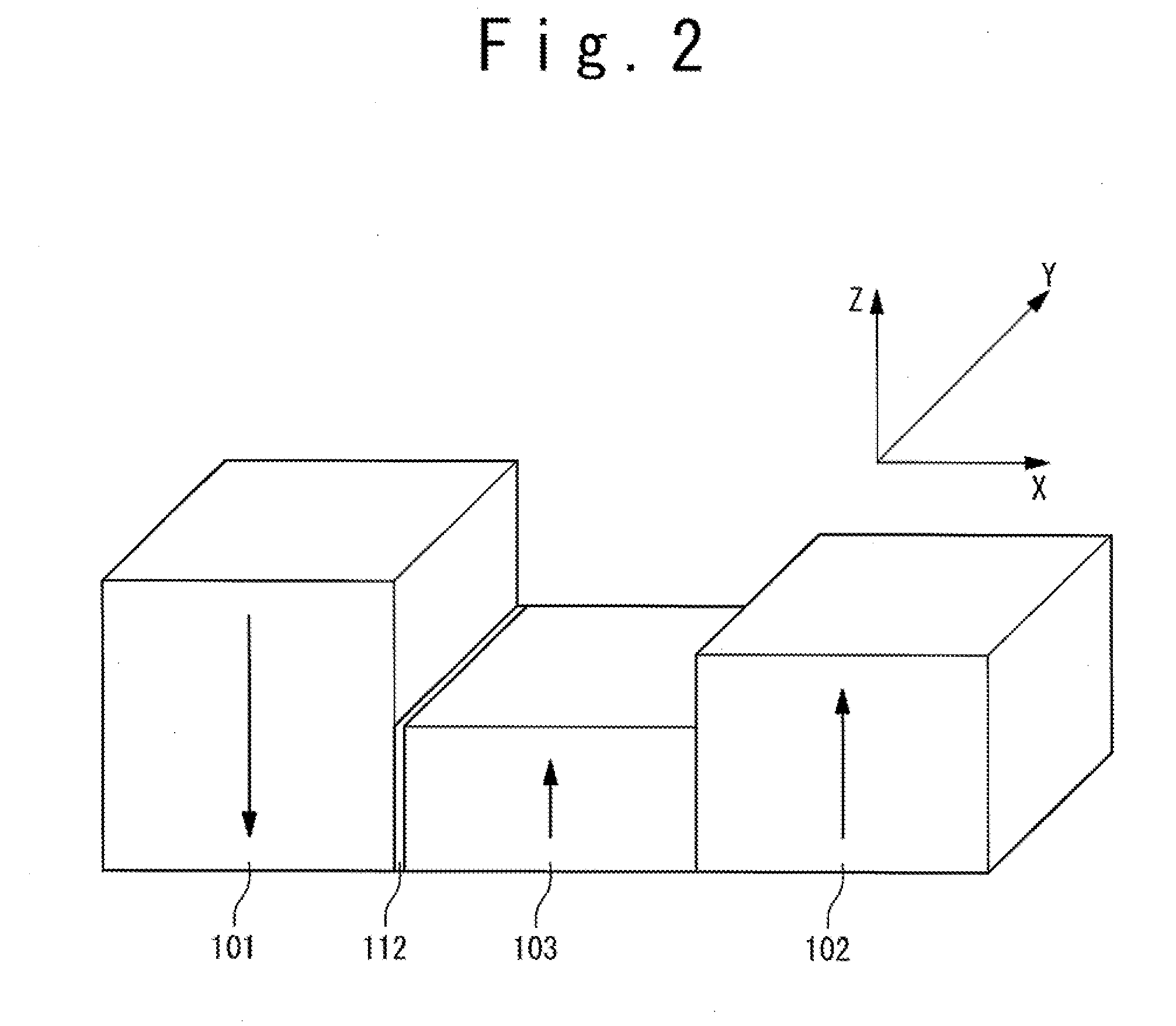Magnetoresistance element, mram, and initialization method for magnetoresistance element
a technology of magnetoresistance element and magnetic random access memory, which is applied in the direction of digital storage, semiconductor devices, instruments, etc., can solve the problems of increasing the number of processes, increasing the cost, and failure in which the domain wall does not stably mov
- Summary
- Abstract
- Description
- Claims
- Application Information
AI Technical Summary
Benefits of technology
Problems solved by technology
Method used
Image
Examples
first embodiment
(Structure of Magnetoresistance Element)
[0053]FIG. 3A is a plan view illustrating a structure of a magnetoresistance element 1 in a first embodiment, FIG. 3B is a cross-sectional view on the L1 cross section, and FIG. 3C is a cross-sectional view on the L2 cross section. As illustrated in FIG. 3A, the magnetoresistance element 1 is provided with a magnetization recording layer 10, a magnetization fixed layer 30, and a tunnel barrier layer 32 provided between them. The tunnel barrier layer 32 is a nonmagnetic dielectric layer, and formed of a thin dielectric film such as an Al2O3 film or a MgO film. The tunnel barrier layer 32 is sandwiched between the magnetization recording layer 10 and the magnetization fixed layer 30, and the magnetization recording layer 10, the tunnel barrier layer 32, and the magnetization fixed layer 30 form a magnetic tunnel junction (MTJ).
[0054]The magnetization recording layer 10 is a ferromagnetic layer having anisotropy in the direction perpendicular to ...
second embodiment
[0090]FIG. 9A is a plan view illustrating the structure of a magnetization recording layer 10 of a magnetoresistance element 1 in a second embodiment of the present invention, FIG. 9B is a cross-sectional view illustrating the structure on the L1 cross-section, and FIG. 9C is a cross-sectional view illustrating the structure on the L2 cross section. The magnetization recording layer 10 includes the first magnetization fixed region 11a, the second magnetization fixed region 11b, and the magnetization reversal region 13. As described above, the magnetization reversal region 13 refers to a region coupled to a tunnel barrier layer and a magnetization fixed layer (both not illustrated) constituting an MTJ.
[0091]In this embodiment, the via contact 14a, the second via contact 14b, and fourth via contacts 14c and 14d are coupled onto the lower surface of the magnetization recording layer 10. The via contacts 14a to 14d are formed in the same via formation process. The first magnetization fi...
third embodiment
[0102]FIG. 14A is a plan view illustrating a configuration of a magnetoresistance element 1 in a third embodiment of the present invention, and FIG. 14B is a cross-sectional view. In the third embodiment, a separating metal layer 38 and a sensing magnetic layer 39 are provided between a tunnel barrier layer 32 and the magnetization recording layer 10, and a film stack including the separating metal layer 38, the sensing magnetic layer 39, the tunnel barrier layer 32, and the magnetization fixed layer 30 is arranged at a position that is offset from the center of the magnetization recording layer 10 in the Y direction. Specifically, the sensing magnetic layer 39 is provided so that a portion thereof is opposed to the magnetization reversal region 13, and the tunnel barrier layer 32 is provided on the sensing magnetic layer 39. The magnetization fixed layer 30 is provided on the tunnel barrier layer 32 so as to be opposed to the sensing magnetic layer 39.
[0103]In the third embodiment,...
PUM
 Login to View More
Login to View More Abstract
Description
Claims
Application Information
 Login to View More
Login to View More - R&D
- Intellectual Property
- Life Sciences
- Materials
- Tech Scout
- Unparalleled Data Quality
- Higher Quality Content
- 60% Fewer Hallucinations
Browse by: Latest US Patents, China's latest patents, Technical Efficacy Thesaurus, Application Domain, Technology Topic, Popular Technical Reports.
© 2025 PatSnap. All rights reserved.Legal|Privacy policy|Modern Slavery Act Transparency Statement|Sitemap|About US| Contact US: help@patsnap.com



